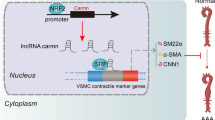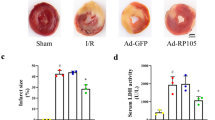Abstract
Atrial fibrosis influences atrial fibrillation (AF) development by transforming growth factor beta 1 (TGF-β1)/Smad pathway. Although microRNAs are implicated in the pathogenesis of various diseases, information regarding the functional role of microRNAs in atrial dysfunction is limited. In the present study, we found that microRNA-27b (miR-27b) was the dominant member of miR-27 family expressed in left atrium. Moreover, the expression of miR-27b was significantly reduced after angiotensin II (AngII) infusion. Masson’s trichrome staining revealed that delivery of miR-27b adeno-associated virus to left atrium led to a decrease in atrial fibrosis induced by AngII. The increased expression of collagen I, collagen III, plasminogen activator inhibitor type 1 and alpha smooth muscle actin was also inhibited after miR-27b upregulation. In isolated perfused hearts, miR-27b restoration markedly attenuated AngII-induced increase in interatrial conduction time, AF incidence and AF duration. Furthermore, our data evidence that miR-27b is a novel miRNA that targets ALK5, a receptor of TGF-β1, through binding to the 3′ untranslated region of ALK5 mRNA. Ectopic miR-27b suppressed luciferase activity and expression of ALK5, whereas inhibition of miR-27b increased ALK5 luciferase activity and expression. Additionally, miR-27b inhibited AngII-induced Smad-2/3 phosphorylation without altering Smad-1 activity. Taken together, our study demonstrates that miR-27b ameliorates atrial fibrosis and AF through inactivation of Smad-2/3 pathway by targeting ALK5, suggesting miR-27b may play an anti-fibrotic role in left atrium and function as a novel therapeutic target for the treatment of cardiac dysfunction.





Similar content being viewed by others
References
Roche PL, Filomeno KL, Bagchi RA, Czubryt MP. Intracellular signaling of cardiac fibroblasts. Compr Physiol. 2015;5(2):721–60. https://doi.org/10.1002/cphy.c140044.
Liu F, Levin MD, Petrenko NB, Lu MM, Wang T, Yuan LJ, Stout AL, Epstein JA, Patel VV. Histone-deacetylase inhibition reverses atrial arrhythmia inducibility and fibrosis in cardiac hypertrophy independent of angiotensin. J Mol Cell Cardiol. 2008;45(6):715–23. https://doi.org/10.1016/j.yjmcc.2008.08.015.
Li D, Shinagawa K, Pang L, Leung TK, Cardin S, Wang Z, Nattel S. Effects of angiotensin-converting enzyme inhibition on the development of the atrial fibrillation substrate in dogs with ventricular tachypacing-induced congestive heart failure. Circulation. 2001;104(21):2608–14.
Leask A. Getting to the heart of the matter: new insights into cardiac fibrosis. Circ Res. 2015;116(7):1269–76. https://doi.org/10.1161/CIRCRESAHA.116.305381.
Massague J. TGFbeta signalling in context. Nat Rev Mol Cell Biol. 2012;13(10):616–30. https://doi.org/10.1038/nrm3434.
Doetschman T, Barnett JV, Runyan RB, Camenisch TD, Heimark RL, Granzier HL, Conway SJ, Azhar M. Transforming growth factor beta signaling in adult cardiovascular diseases and repair. Cell Tissue Res. 2012;347(1):203–23. https://doi.org/10.1007/s00441-011-1241-3.
Xu P, Liu J, Derynck R. Post-translational regulation of TGF-beta receptor and Smad signaling. FEBS Lett. 2012;586(14):1871–84. https://doi.org/10.1016/j.febslet.2012.05.010.
van den Berg NWE, Kawasaki M, Berger WR, Neefs J, Meulendijks E, Tijsen AJ, de Groot JR. MicroRNAs in atrial fibrillation: from expression signatures to functional implications. Cardiovasc Drugs Ther. 2017;31(3):345–65. https://doi.org/10.1007/s10557-017-6736-z.
Devaux Y, Mueller M, Haaf P, Goretti E, Twerenbold R, Zangrando J, Vausort M, Reichlin T, Wildi K, Moehring B, Wagner DR, Mueller C. Diagnostic and prognostic value of circulating microRNAs in patients with acute chest pain. J Intern Med. 2015;277(2):260–71. https://doi.org/10.1111/joim.12183.
Wang GK, Zhu JQ, Zhang JT, Li Q, Li Y, He J, Qin YW, Jing Q. Circulating microRNA: a novel potential biomarker for early diagnosis of acute myocardial infarction in humans. Eur Heart J. 2010;31(6):659–66. https://doi.org/10.1093/eurheartj/ehq013.
Harling L, Lambert J, Ashrafian H, Darzi A, Gooderham NJ, Athanasiou T. Elevated serum microRNA 483-5p levels may predict patients at risk of post-operative atrial fibrillation. Eur J Cardio Thorac Surg Off J Eur Assoc Cardio Thorac Surg. 2017;51(1):73–8. https://doi.org/10.1093/ejcts/ezw245.
Lu Y, Hou S, Huang D, Luo X, Zhang J, Chen J, Xu W. Expression profile analysis of circulating microRNAs and their effects on ion channels in Chinese atrial fibrillation patients. Int J Clin Exp Med. 2015;8(1):845–53.
Liu Z, Zhou C, Liu Y, Wang S, Ye P, Miao X, Xia J. The expression levels of plasma micoRNAs in atrial fibrillation patients. PLoS One. 2012;7(9):e44906. https://doi.org/10.1371/journal.pone.0044906.
McManus DD, Lin H, Tanriverdi K, Quercio M, Yin X, Larson MG, Ellinor PT, Levy D, Freedman JE, Benjamin EJ. Relations between circulating microRNAs and atrial fibrillation: data from the Framingham Offspring Study. Heart Rhythm. 2014;11(4):663–9. https://doi.org/10.1016/j.hrthm.2014.01.018.
Lu Y, Zhang Y, Wang N, Pan Z, Gao X, Zhang F, Zhang Y, Shan H, Luo X, Bai Y, Sun L, Song W, Xu C, Wang Z, Yang B. MicroRNA-328 contributes to adverse electrical remodeling in atrial fibrillation. Circulation. 2010;122(23):2378–87. https://doi.org/10.1161/CIRCULATIONAHA.110.958967.
Bernardo BC, Nguyen SS, Gao XM, Tham YK, Ooi JY, Patterson NL, Kiriazis H, Su Y, Thomas CJ, Lin RC, Du XJ, McMullen JR. Inhibition of miR-154 protects against cardiac dysfunction and fibrosis in a mouse model of pressure overload. Sci Rep. 2016;6:22442. https://doi.org/10.1038/srep22442.
Wakisaka O, Takahashi N, Shinohara T, Ooie T, Nakagawa M, Yonemochi H, Hara M, Shimada T, Saikawa T, Yoshimatsu H. Hyperthermia treatment prevents angiotensin II-mediated atrial fibrosis and fibrillation via induction of heat-shock protein 72. J Mol Cell Cardiol. 2007;43(5):616–26. https://doi.org/10.1016/j.yjmcc.2007.08.005.
Kume O, Takahashi N, Wakisaka O, Nagano-Torigoe Y, Teshima Y, Nakagawa M, Yufu K, Hara M, Saikawa T, Yoshimatsu H. Pioglitazone attenuates inflammatory atrial fibrosis and vulnerability to atrial fibrillation induced by pressure overload in rats. Heart Rhythm. 2011;8(2):278–85. https://doi.org/10.1016/j.hrthm.2010.10.029.
van Rooij E, Sutherland LB, Liu N, Williams AH, McAnally J, Gerard RD, Richardson JA, Olson EN. A signature pattern of stress-responsive microRNAs that can evoke cardiac hypertrophy and heart failure. Proc Natl Acad Sci USA. 2006;103(48):18255–60. https://doi.org/10.1073/pnas.0608791103.
Veliceasa D, Biyashev D, Qin G, Misener S, Mackie AR, Kishore R, Volpert OV. Therapeutic manipulation of angiogenesis with miR-27b. Vasc Cell. 2015;7:6. https://doi.org/10.1186/s13221-015-0031-1.
Zou B, Ge Z, Zhu W, Xu Z, Li C. Persimmon tannin represses 3T3-L1 preadipocyte differentiation via up-regulating expression of miR-27 and down-regulating expression of peroxisome proliferator-activated receptor-gamma in the early phase of adipogenesis. Eur J Nutr. 2015;54(8):1333–43. https://doi.org/10.1007/s00394-014-0814-9.
Sun L, Trajkovski M. MiR-27 orchestrates the transcriptional regulation of brown adipogenesis. Metab Clin Exp. 2014;63(2):272–82. https://doi.org/10.1016/j.metabol.2013.10.004.
Zhang M, Wu JF, Chen WJ, Tang SL, Mo ZC, Tang YY, Li Y, Wang JL, Liu XY, Peng J, Chen K, He PP, Lv YC, Ouyang XP, Yao F, Tang DP, Cayabyab FS, Zhang DW, Zheng XL, Tian GP, Tang CK. MicroRNA-27a/b regulates cellular cholesterol efflux, influx and esterification/hydrolysis in THP-1 macrophages. Atherosclerosis. 2014;234(1):54–64. https://doi.org/10.1016/j.atherosclerosis.2014.02.008.
Xie W, Li L, Zhang M, Cheng HP, Gong D, Lv YC, Yao F, He PP, Ouyang XP, Lan G, Liu D, Zhao ZW, Tan YL, Zheng XL, Yin WD, Tang CK. MicroRNA-27 prevents atherosclerosis by suppressing lipoprotein lipase-induced lipid accumulation and inflammatory response in apolipoprotein E knockout mice. PLoS One. 2016;11(6):e0157085. https://doi.org/10.1371/journal.pone.0157085.
Chinchilla A, Lozano E, Daimi H, Esteban FJ, Crist C, Aranega AE, Franco D. MicroRNA profiling during mouse ventricular maturation: a role for miR-27 modulating Mef2c expression. Cardiovasc Res. 2011;89(1):98–108. https://doi.org/10.1093/cvr/cvq264.
Hernandez-Torres F, Martinez-Fernandez S, Zuluaga S, Nebreda A, Porras A, Aranega AE, Navarro F. A role for p38alpha mitogen-activated protein kinase in embryonic cardiac differentiation. FEBS Lett. 2008;582(7):1025–31. https://doi.org/10.1016/j.febslet.2008.02.050.
Sayed D, Hong C, Chen IY, Lypowy J, Abdellatif M. MicroRNAs play an essential role in the development of cardiac hypertrophy. Circ Res. 2007;100(3):416–24. https://doi.org/10.1161/01.RES.0000257913.42552.23.
Lijnen PJ, Petrov VV, Fagard RH. Induction of cardiac fibrosis by transforming growth factor-beta(1). Mol Genet Metab. 2000;71(1–2):418–35. https://doi.org/10.1006/mgme.2000.3032.
Kuwahara F, Kai H, Tokuda K, Kai M, Takeshita A, Egashira K, Imaizumi T. Transforming growth factor-beta function blocking prevents myocardial fibrosis and diastolic dysfunction in pressure-overloaded rats. Circulation. 2002;106(1):130–5.
Cheng R, Dang R, Zhou Y, Ding M, Hua H. MicroRNA-98 inhibits TGF-beta1-induced differentiation and collagen production of cardiac fibroblasts by targeting TGFBR1. Hum Cell. 2017;30(3):192–200. https://doi.org/10.1007/s13577-017-0163-0.
Hong Y, Cao H, Wang Q, Ye J, Sui L, Feng J, Cai X, Song H, Zhang X, Chen X. MiR-22 may suppress fibrogenesis by targeting TGFbetaR I in cardiac fibroblasts. Cell Physiol Biochem Int J Exp Cell Physiol Biochem Pharmacol. 2016;40(6):1345–53. https://doi.org/10.1159/000453187.
Zhao X, Wang K, Liao Y, Zeng Q, Li Y, Hu F, Liu Y, Meng K, Qian C, Zhang Q, Guan H, Feng K, Zhou Y, Du Y, Chen Z. MicroRNA-101a inhibits cardiac fibrosis induced by hypoxia via targeting TGFbetaRI on cardiac fibroblasts. Cell Physiol Biochem Int J Exp Cell Physiol Biochem Pharmacol. 2015;35(1):213–26. https://doi.org/10.1159/000369689.
Morine KJ, Qiao X, Paruchuri V, Aronovitz MJ, Mackey EE, Buiten L, Levine J, Ughreja K, Nepali P, Blanton RM, Oh SP, Karas RH, Kapur NK. Reduced activin receptor-like kinase 1 activity promotes cardiac fibrosis in heart failure. Cardiovasc Pathol Off J Soc Cardiovasc Pathol. 2017;31:26–33. https://doi.org/10.1016/j.carpath.2017.07.004.
Wang Q, Yu Y, Zhang P, Chen Y, Li C, Chen J, Wang Y, Li Y. The crucial role of activin A/ALK4 pathway in the pathogenesis of Ang-II-induced atrial fibrosis and vulnerability to atrial fibrillation. Basic Res Cardiol. 2017;112(4):47. https://doi.org/10.1007/s00395-017-0634-1.
Hu J, Wang X, Wei SM, Tang YH, Zhou Q, Huang CX. Activin A stimulates the proliferation and differentiation of cardiac fibroblasts via the ERK1/2 and p38-MAPK pathways. Eur J Pharmacol. 2016;789:319–27. https://doi.org/10.1016/j.ejphar.2016.07.053.
Author information
Authors and Affiliations
Corresponding author
Ethics declarations
Ethical standards
All animal experiments were carried out according to the institutional guidelines from the Care and Use of Laboratory Animals of Cangzhou Central Hospital and were approved by the Institutional Animal Ethics Committee.
Conflict of interest
The authors declare that they have no conflict of interest.
Rights and permissions
About this article
Cite this article
Wang, Y., Cai, H., Li, H. et al. Atrial overexpression of microRNA-27b attenuates angiotensin II-induced atrial fibrosis and fibrillation by targeting ALK5. Human Cell 31, 251–260 (2018). https://doi.org/10.1007/s13577-018-0208-z
Received:
Accepted:
Published:
Issue Date:
DOI: https://doi.org/10.1007/s13577-018-0208-z




